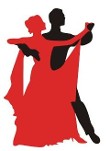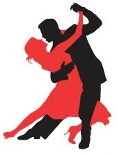Lead and Follow
Lead and Follow
In partner dancing, the two dancers are sometimes not equal. One takes the Lead and the other is the Follow.
The Lead (conventionally the male in a mixed-sex couple) is responsible for choosing appropriate steps to suit the music (if it is an improvised dance), and leading the Follow by using subtle signals to complete the chosen steps smoothly and safely. If the dance is a set (pre-choreographed) routine, the Lead is sometimes responsible for initiating each move, which ensures smooth coordination between the two dancers.
Theory
The degree to which the Lead controls the dance (and, by implication, "controls" the Follower) depends on the dance style and dancer sensitivity, the social context in which the dance exists, the experiences and personalities of each partner, and a range of other factors. Some partner dances such as Lindy Hop involve an open position which encourages each partner to improvise alone, yet others, such as Argentine Tango may involve a "close embrace" or closed position which require Followers to follow the Lead more comprehensively.
For many individual dancers, exploring the limits of the Leader-Follower relationship adds to the dance, where this relationship might better be understood as a conversation between partners, with each contributing to the style and mood of the dance through their connection. For other partners, the lead's complete control of the follower, and the follower's relinquishing a greater degree of creative or expressive autonomy is more personally comfortable or satisfying.
Social partner dance principles
For the Leader and Follower to interact with each other, communication needs to occur between the dance couple. Because it's not practical to discuss moves, physical contact is the most effective means. More advanced dancers will take many cues from each other through this connection, with the Follower using it to communicate feedback to the Leader just as the Leader uses it to suggest moves to their partner. The most accomplished dancers use connection as a line of communication which allows the leader to incorporate the follower's ideas, abilities, and creative suggestions into their own styling and selection of moves.
In many partner dances, the lead's steps differ from the follower's. In face-to-face positions, the follower generally "mirrors" the lead's footwork. For example, if the lead begins on their left foot, the follow will begin on their right foot. In choreographed pieces and other situations where the follow is in a tandem position or shadow position, the lead and follow will use the same footwork. Usually both partners move together as a unit, but in some dances the partners move in opposite directions - together and apart again.
In partner dancing, dancers seek to work together to create synchronised or complementary movements. The lead is largely responsible for initiating movement, whereas the follow's role is to maintain this movement (though they may choose not to). Many dancers describe this process as involving the initiation of momentum or 'energy' (by the lead) and then the subsequent maintenance, exaggeration, decreasing or dissolving of this momentum by both partners. This momentum or energy may be manifested as movement (in its most obvious form), or in a range of more complex interactions between partners:
- Compression (where each partner 'compress' the energy by bending joints and moving towards or 'into' their partner, to varying degrees);
- Leverage (where one partner - usually the lead - exploits the development of compression or connection to shift their follow's weight or to 'ground' (develop 'compression' downwards, with the contact their feet make with the floor) themselves more thoroughly before initiating movement);
- Tension (is the opposite of compression - partners moving away from each other but still in contact)
Weight transfer
For partner dancers, using weight transfers is a way for a Lead to communicate a 'lead' for a dance step to a Follow.
For example, when a couple is physically in contact each other, for a Lead to have their Follow walk forwards, they may simply begin by walking backwards themselves. As their arms/points of contact move away from each other, they develop tension, which the follow may either break by dropping their arms or breaking the hold, or 'follow' by moving.
A more experienced Lead may realize (if only on an unconscious level) that the most effective execution of even this "simple" step is achieved by preparing for movement before the step begins.
The Lead-Follow connection facilitates this. The principles of Leading and Following are explored to their most extreme limits in contact improvisation of modern dance, though they are as ancient a process as a parent carrying a child.
Advanced swing dancers do this to enhance their dance connection and to add more fun into the dance. Another way of "breaking the routine" of the dance is syncopation (the second meaning, making more steps than required by the standard description of the dance pattern). Syncopations are easier for the lead to cope with, since the lead does not have to change the intended dance figure, although experienced dancers try and match the fancy footwork of the partner, at least in rhythm. So, in a sense, syncopation may be perceived as mild hijacking. This is not as difficult as it might seem, since good dancers match their footwork to musical accents.
Travel
Obstruction avoidance
A general rule is that both lead and follow watch each other's back in a dance hall situation. Collision avoidance is one of the cases when the follow is required to "backlead" or at least to communicate about the danger to the lead. In travelling dances, such as Waltz, common Follow signals of danger are an unusual resistance to the Lead, or a slight tap by the shoulder. In open-position dances, such as Swing or Latin dances, maintaining eye contact with the partner is an important safety communication link.
Recovery from miscommunication
Sometimes a miscommunication is possible between the Lead and Follow. A general rule here is do not wrestle and never stop dancing. Techniques of the recovery of connection and synchronization vary from dance to dance, but there are some common tricks.
- In dances without obligatory body contact (Latin, swing, hustle, American Smooth), free spin recovers from anything.
- In dances danced in body contact (Waltz, Tango) it is very important to recover the feet match. To recover, Leads may initiate a well-known (i.e. basic) step with slightly exaggerated sideways shift of weight to force the Follow to free the required foot. For example, in Waltz or Foxtrot a good suggestion would be to end a measure in the open Promenade position, there would be no doubt as to the direction of the movement and which foot to use at the beginning of the next measure.
History of gender roles
Traditionally, the male dance partner is the Lead and the female dance partner is the Follow, though this is not always the case. Many social dance forms have a long history of same-sex and role-crossing partnerships, and there have been some changes to the strict gendering of partner dances in some competition or performance contexts. An example is a "Jack and Jack" dance contest.
Lead
Methods to lead
Body lead vs. arm lead
A body lead occurs where the leader initiates a lead by moving their body, which moves their arm(s), and thus transmits a lead to the follow. 'Body lead' means much the same as 'weight transfer'. An arm lead occurs where the leader moves their arm(s) without moving their body, or moves their body in a different direction to their arm. While an 'arm lead' without the transfer of weight (or movement of the body) on the part of the leader is often a marker of an inexperienced or poorly taught dancer, the process of leading and following, particularly at an advanced level, often involves the contra- and contrasting uses of weight transfers and 'arm moves'. As an example, a leader may lead a follow back onto their right foot through the leader's own weight transfer forwards onto their left foot; yet at the same time turn the follower's torso to the left from above the hips.
Techniques of leading
The Lead has to communicate the direction of the movement to the Follow. Traditionally, the Lead's right hand on the follow's back, near the lowest part of the shoulder-blade. This is the strongest part of the back and the lead can easily pull the Follow's body inwards. To enable the Lead to communicate a step forward (backward for the Follow) the Follow has to constantly put a little weight against the Lead's right hand. When the Lead goes forward, the Follow will naturally go backwards.
An important leading mechanism is the Lead's left hand, which usually holds the Follow's right hand. At no point should it be necessary for any partner to firmly grab the other's hand. It is sufficient to press the hand or even only finger tips slightly against each other, the Follows hand following the Leads hand.
Another important leading mechanism is hip contact. Though not possible in traditional Latin dances like Rumba, Cha-cha, Tango Argentino because of partner separation, hip contact is a harmonious and sensual way of communicating movement to the partner, used primarily in Standard or Ballroom Dances (English / slow Waltz, European Tango, Quickstep etc.) and Caribbean dances.
Follow
Types of follow
- Active Follow
- Passive Follow
Techniques of Following
Backleading
'Backleading' is when a Follow is executing steps without waiting for, or contrary to, or interfering with the Lead's lead. Both are considered bad dancing habits because it makes the Follow difficult to lead and dance with.
Backleading can be a teaching tool that is often used intentionally by an instructor when dancing with a student lead, in order to help them learn the desired technique.
Backleading sounds similar to "hijacking", and indeed it is often used in place of "hijacking". However the two terms have significant differences, stemming from intentions. The first, superficial, difference: hijacking is usually an occasional "outburst" of the Follow, which otherwise diligently follows the lead, while a "backlead" may do this almost on every other step. The second, a more significant one: hijacking is an actual Lead, i.e., a hijacker does their stuff and watches for the 'Lead' to 'Follow' (reversed roles!), while backleading is taking care only about one's own dancing.
Hijacking
Sometimes the follow steals the lead and they reverse roles for some time. This is called hijacking (also known as lead stealing). Hijacking requires experience and good connection, since without proper timing it may look like sloppy dancing. A signal for hijacking is typically an unusually changed (mostly, increased) stress in the connection from the follow's side. "Unusually" means more than typically required for the execution of the current step (by these partners). For a follow to hijack, they must be sure that the lead will understand or at least guess the follow's intentions.











